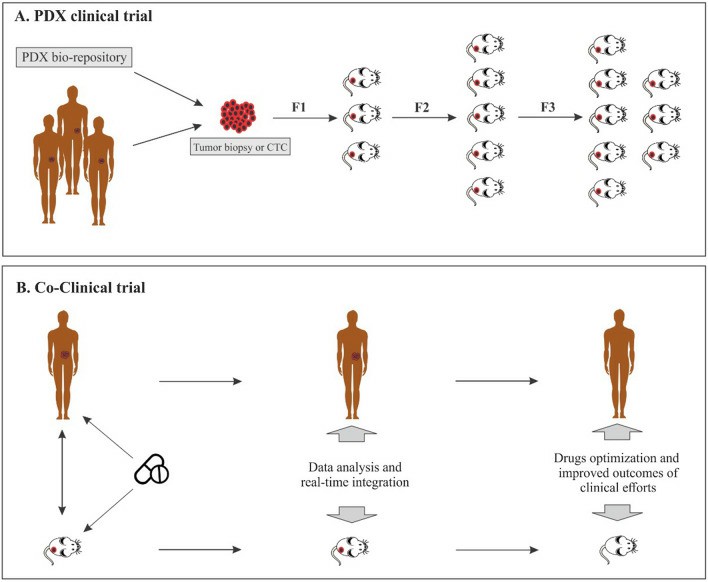Why Use PDX Models for Cancer Research?
Patient-derived xenograft (PDX) models have emerged as valuable tools in cancer research, offering a unique opportunity to bridge the gap between preclinical and clinical studies. These models involve the transplantation of patient tumor tissues into immunodeficient mice, allowing researchers to study tumor behavior, therapeutic responses, and molecular characteristics in a more clinically relevant context.
Preclinical Drug Efficacy Testing
One of the primary applications of PDX models in cancer research is the evaluation of drug efficacy. PDX models provide a platform to assess the response of patient tumors to various anticancer drugs and treatment regimens. By implanting tumor tissues from different patients into mice, researchers can test the effectiveness of potential therapies and identify optimal treatment strategies. This preclinical testing enables the selection of promising drug candidates for further development and clinical trials.
 Fig. 1 PDX clinical trial and Co-clinical trial. (Mashouri L, et al., 2019)
Fig. 1 PDX clinical trial and Co-clinical trial. (Mashouri L, et al., 2019)
Mechanism of Action and Resistance Studies
Understanding the mechanisms of drug action and resistance is crucial for developing effective cancer treatments. PDX models offer a valuable platform for investigating these mechanisms in a controlled environment. Researchers can study the molecular pathways involved in drug response and resistance by comparing the gene expression profiles, protein signatures, and histopathological features of PDX models with the corresponding patient tumors.
Tumor Heterogeneity and Evolution Studies
Tumor heterogeneity, the presence of genetically distinct subpopulations within a tumor, poses significant challenges in cancer treatment. PDX models enable researchers to study tumor heterogeneity and clonal evolution over time, providing insights into tumor progression, metastasis, and treatment response.
By analyzing different regions of PDX tumors and comparing them with the corresponding patient tumors, they have identified spatial and temporal variations in gene expression patterns and genetic alterations. This understanding of tumor evolution has the potential to guide the development of personalized treatment strategies targeting specific subpopulations within tumors.
Exploring Tumor Microenvironment Interactions
The tumor microenvironment plays a critical role in cancer development, progression, and response to therapy. PDX models allow researchers to study the interactions between tumor cells and the surrounding stromal components, including immune cells, blood vessels, and extracellular matrix.
By implanting patient tumor tissues into immunodeficient mice with a functional human immune system, they have been able to assess immune cell infiltration, tumor immune evasion mechanisms, and the response to immunotherapies. These studies have contributed to the development of novel immunotherapeutic strategies and the identification of predictive biomarkers for immunotherapy response.
Personalized Medicine and Biomarker Discovery
PDX models have revolutionized the concept of personalized medicine by providing a platform for testing individual patient tumors and tailoring treatment strategies accordingly. By implanting patient tumor tissues into mice, researchers can predict patient-specific responses to therapies and identify biomarkers associated with treatment response or resistance.
By analyzing the molecular profiles of PDX models and correlating them with patient clinical data, researchers have identified genetic and molecular biomarkers that can guide treatment decisions. These biomarkers can help stratify patients, predict treatment response, and ultimately improve patient outcomes.
Creative Bioarray Relevant Recommendations
To better preserve the genomic integrity and tumor heterogeneity observed in patients, PDX models were generated using freshly resected patient tumors that were immediately transplanted into immunocompromised mouse hosts without any intermediate in vitro culture step. Creative Bioarray focuses on anti-tumor drug discovery and development services to help clients evaluate compound efficacy and investigate associated pathological mechanisms.
| Product/Service Types | Description |
| Oncology Models | Creative Bioarray provides a wealth of oncology models, including cell line-derived xenograft (CDX), PDX, syngeneic and orthotopic, gene-edited animal, and chemically induced animal models. |
| Tumor Cells | Creative Bioarray's tumor cell panels are based on key components of cell signaling pathways or cancer genes. |
| PDX-based Drug Screening | With extensive experience in the field of PDX models, we are confident to help you overcome any upcoming challenges. |
| CDX-based Drug Screening | With years of operational experience and a technology platform of CDX models, Creative Bioarray focuses on anti-tumor drug research and development services to help customers assess the efficacy of compounds and study the associated pathological mechanisms. |
Reference
- Abdolahi S, et al. (2022). "Patient-derived xenograft (PDX) models, applications and challenges in cancer research." J Transl Med. 20 (1), 206.